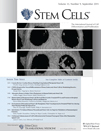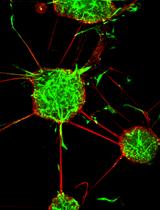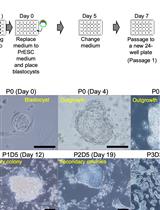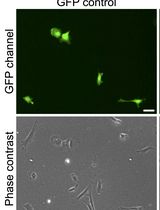- EN - English
- CN - 中文
Retinal Differentiation of Mouse Embryonic Stem Cells
小鼠胚胎干细胞的视网膜分化
发布: 2016年07月05日第6卷第13期 DOI: 10.21769/BioProtoc.1851 浏览次数: 14856
评审: Hui ZhuPatrick Ovando-RocheAnonymous reviewer(s)
Abstract
Groundbreaking studies from Dr. Yoshiki Sasai’s laboratory have recently introduced novel methods to differentiate mouse and human Embryonic Stem Cells (mESCs and hESCs) into organ-like 3D structures aimed to recapitulate developmental organogenesis programs (Eiraku et al., 2011; Eiraku and Sasai, 2012; Nakano et al., 2012; Kamiya et al., 2011). We took advantage of this method to optimize a 3D protocol to efficiently generate retinal progenitor cells and subsequently retinal neurons in vitro. This culture system provides an invaluable platform both to study early developmental processes and to obtain retinal neurons for transplantation approaches. The protocol described here has been successfully applied to several mouse ESC (including the R1, WD44 and G4 cell lines) and mouse induced-Pluripotent Stem Cell (iPSCs) lines.
Keywords: Retina (视网膜)Materials and Reagents
- 96-well ultra low-cell-adhesion plate, Lipidure-Coat (Amsbio LLC, catalog number: AMS.51011610 ) or PrimeSurface 96U plate (Sumitomo Bakelite, catalog number: MS-9096U )
- 6-well ultra low-cell-adhesion plate (Thermo Fisher Scientific, CorningTM, catalog number: 07-200-601 )
- 100 mm cell culture dish (Corning, BD Falcon®, catalog number: 353003 )
- Glass Pasteur pipette
- Mouse Embryonic Stem Cells (mESCs) or mouse Induced-Pluripotent Stem Cells (miPSCs)
- Phosphate Buffer Saline (PBS) (Thermo Fisher Scientific, GibcoTM, catalog number: 10010-023 )
- Water, cell culture grade (Thermo Fisher Scientific, catalog number: 15230-162 )
- Dulbecco’s Modified Eagle Medium (DMEM) high glucose (Thermo Fisher Scientific, GibcoTM, catalog number: 10564-011 )
- Glasgow’s MEM (GMEM) (Thermo Fisher Scientific, GibcoTM, catalog number: 11710-035 )
- Dulbecco’s modified Eagle’s medium/nutrient F-12 Ham (DMEM/F12 Ham) (Thermo Fisher Scientific, GibcoTM, catalog number: 10565-018 )
- Fetal Bovine Serum (FBS), ESC Qualified (Thermo Fisher Scientific, catalog number: 10439-024 )
- Knock-Out Serum Replacement (KSR) (Thermo Fisher Scientific, GibcoTM, catalog number: 10828-028 )
- Mixture of penicillin and streptomycin (Pen/Strep) (Thermo Fisher Scientific, GibcoTM, catalog number: 15140-122 )
- Leukemia Inhibitory Factor (LIF) (Merck Millipore Corporation, catalog number: ESG1107 )
- GSK3b inhibitor (Stemolecule CHIR99021) (Stemgent, catalog number: 04-0004-02 )
- MAPK/ERK inhibitor (Stemolecule PD0325901) (Stemgent, catalog number: 04-0006-02 )
- TrypLE Trypsin Replacement (Thermo Fisher Scientific, catalog number: 12605-028 )
- 10 mM non-essential amino acids (NEAA) solution (Thermo Fisher Scientific, GibcoTM, catalog number: 11140-050 )
- Sodium pyruvate solution (Thermo Fisher Scientific, GibcoTM, catalog number: 11360-070 )
- 2-mercaptoethanol (2-ME) (Sigma-Aldrich, catalog number: M7522 )
- Growth factor reduced Matrigel® (GFR Matrigel) (Corining®, catalog number: 356230 )
- B27 supplement (Thermo Fisher Scientific, GibcoTM, catalog number: 17504044 )
- N2 supplement (Thermo Fisher Scientific, GibcoTM, catalog number: 17502-048 )
- All-trans retinoic acid (Sigma-Aldrich, catalog number: R2625-50MG )
- Taurine (Sigma-Aldrich, catalog number: T-8691 )
- MEF medium (see Recipes)
- LIF + 2i medium (see Recipes)
- Retinal Differentiation medium (RD medium) (see Recipes)
- Tom’s medium (see Recipes)
Equipment
- Incubator (37 °C and 5% CO2) (Thermo Scientific, model: HERACell 150i )
- Centrifuge (Eppendorf, model: Conical centrifuge 5702 )
- Tissue culture hood, Type B2 Biological Safety Cabinet (Thermo Scientific, model: 1300 Series Class II )
- Hemocytometer (Neubauer chamber) or equivalent method
- Inverted microscope (Leica, model: DMi8 )
Procedure
文章信息
版权信息
© 2016 The Authors; exclusive licensee Bio-protocol LLC.
如何引用
La Torre, A. (2016). Retinal Differentiation of Mouse Embryonic Stem Cells. Bio-protocol 6(13): e1851. DOI: 10.21769/BioProtoc.1851.
分类
干细胞 > 胚胎干细胞 > 维持和分化
您对这篇实验方法有问题吗?
在此处发布您的问题,我们将邀请本文作者来回答。同时,我们会将您的问题发布到Bio-protocol Exchange,以便寻求社区成员的帮助。
提问指南
+ 问题描述
写下详细的问题描述,包括所有有助于他人回答您问题的信息(例如实验过程、条件和相关图像等)。
Share
Bluesky
X
Copy link













